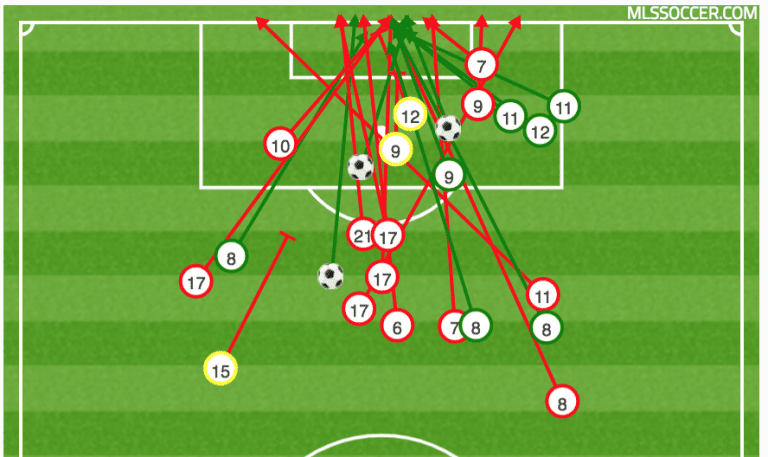MLS, which is closing in on the end of its 23rd season, is still a league of parity. But I would say it's time to adjust our modifier, as it's no longer a league of "extreme" parity, but rather one of "relative" parity.
And that I mean this: Toronto FC set the single-season points record in 2017 (69 points). Atlanta United matched it in 2018, and the New York Red Bulls (71 points) bettered it. Both those teams pretty resoundingly marched through the conference semifinals, showing particular ferocity in leave-no-doubt-about it 2nd leg wins at home. The best teams won, and then advanced.
In the Western Conference, Sporting KC weren't quite as dominant as RBNY and Atlanta, but their point total (62) would've been enough to win them the Supporters' Shield in 2013, 15 and 16. They were the No. 1 seed in the West, and while their conference semifinal win over RSL wasn't smooth, in the end they got a road draw and a multi-goal home win. The best team won, and advanced.
The only outlier were the Seattle Sounders, who were the sole top four seed to go down. It took a wild, spectacular effort (and a PK shootout) from the Portland Timbers to vanquish their northern neighbors, which is fitting for Conference Championship round party-crashers.
Such is the story of the Audi 2018 MLS Cup Playoffs thus far. Let's take a look at what's to come:
Western Conference
Portland Timbers vs. Sporting KC
7:30 pm ET | Match Preview | TV & streaming info
Portland went through the same evolution as Atlanta, but they did so 1) out of a sense of desperation, and 2) twice. The Timbers came out back in March and couldn't do pretty much anything right, which eventually led new coach Gio Savarese to decide a bunker was their best bet. They went to an ultra-defensive 4-3-2-1 formation, put as many as nine of those guys behind the ball, and often pulled seven of them into the central zone.
They ran off 15 unbeaten. It was good.
But Savarese also felt that, at some point, the team needed a Plan B. And that led to a summer of not-so-great results as his idea for a Plan B was to come upfield and possess the ball a little bit more. While this makes sense in a lot of ways – the Timbers have some highly skilled midfielders – the strain it put on a less-than-highly-mobile backline and an uncertain defensive midfield rotation proved to be much too much. When Portland tried to use the ball, it rarely ended well.
So come October, they went back to the bunker. But this time there was a wrinkle, as the formation had changed: It was now a 4-2-3-1. And the personnel had changed as well, with a target No. 9 in Jeremy Ebobisse replacing a more goal-oriented, channel-running No. 9 in Samuel Armenteros:
This type of work from Ebobisse allowed Portland to change where on the field the creative fulcrum was at any given moment. For much of the year it had all come from the midfield via Diego Valeri and Sebastian Blanco, and while those guys are damn good, that only gets you so far. With a center forward who can bring them into the game, and another true winger (usually Andy Polo, who's honest if not dynamic), the way teams have had to defend Portland has changed even if the overall Timbers gameplan – absorb, then break – has not.
The other effect of going to the 4-2-3-1 is that it's asked a lot less of Portland's fullbacks in terms of getting forward, which has meant they're much more static, and thus tougher to break down defensively.
I'm not sure exactly what that'll mean for a Sporting team that was one of the league's best in attack this season even as they became, at times, shockingly frail defensively. SKC have lived to attack the "B" gaps between the fullbacks and center backs, hitting them at pace with a cadre of speedy, goal-dangerous wingers. It is their bread and butter.
What do they do if those gaps are super tight, or simply don't exist at all because the fullbacks are playing like classic defenders rather than modern, overlapping, two-way threats? Like I said above, I'm not sure.
What I am sure of is that they will not hesitate to shoot when they get into Zone 14. This is their shot map from a 3-0 win over the Timbers this summer:

The idea here is twofold. First... most shots from Zone 14 aren't bad! Granted they'll miss Diego Rubio in this one (he's suspended, which means Khiry Shelton is guaranteed to start as the No. 9, and Shelton is nowhere near as goal-dangerous as Rubio), but sometimes a 25-yard blast goes in.
Second, shoot from these spots enough and you end up making the center backs at least a little bit skittish, putting into their heads the notion that they do, in fact, have to leave the comfort of the 18 and come out to challenge a little bit. Both Larrys Mabiala and Liam Ridgewell are veteran, been-there-done-that guys, but neither is at their best defending in space anymore. Pull them out and you create gaps to potentially combo through, and maybe create a channel to run in behind.
Under normal circumstances I'd say that this game has the potential to be super cagey, but RSL have put the fear of God into me about SKC's defense. I'm not even sure they can win a cagey game at this point, so they might have to just go for it.
X-factor:Graham Zusi's push. When he gets very, very high upfield, it often brings SKC's attack to another level. It also leaves them wildly exposed to a good counterattack, which... yeah, Portland wouldn't mind that.
I wouldn't be shocked if Peter Vermes tweaked Zusi's positioning just a bit.
One More Thing To Ponder
Happy weekending, everybody. Stay warm.













